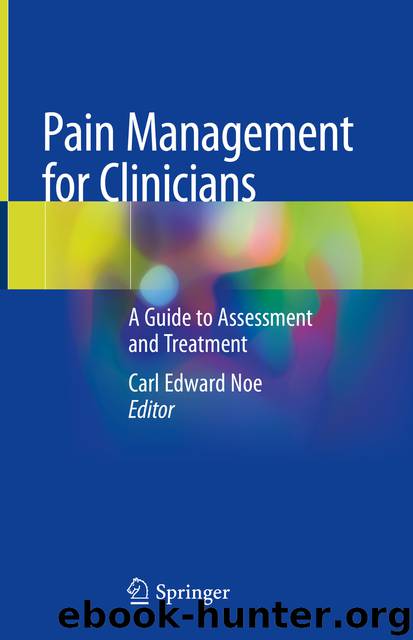Pain Management for Clinicians by Unknown

Author:Unknown
Language: eng
Format: epub
ISBN: 9783030399825
Publisher: Springer International Publishing
Jason Zafereo
Email: [email protected]
Keywords
Physical therapyPain rehabilitationExerciseManual therapyEducationModalitiesMechanism-based classificationEvidence-based practice
Introduction
Physical therapy is considered a cost-effective, evidence-based treatment option for a variety of medical conditions [1]. Physical therapists are specially trained to analyze and address dysfunctions in the movement system. When pain is believed to be precipitated by, perpetuated from, or having a deleterious effect on movement, a physical therapist can provide skilled interventions to alleviate pain and improve physical function. Evidence suggests that early referrals to physical therapy are vital to a patient’s enhanced recovery and to the reduction of overall healthcare utilization related to the presenting condition [2, 3]. More specifically, early physical therapy has been associated with reduced long-term opioid use for shoulder, knee, and low back pain [4, 5].
Physical therapy should not be administered via a protocol-driven, onesize- fits all manner. Rather, physical therapists should consider the unique biopsychosocial factors that contribute to each patient’s pain when developing a treatment plan. This process begins with a detailed history and examination, which allows therapists to identify potential biological structures (e.g., the spine) or psychosocial beliefs (e.g., fear avoidance) that may contribute to pain and/or movement dysfunction. Based on the findings from the examination, therapists can then prioritize treatment to the primary impairment(s) to movement, whether they be physical, environmental, or psychological. A detailed description of the clinical reasoning process required to adequately identify and discriminate a patient’s primary contributing factors to pain is beyond the scope of this chapter. Truly, it is largely this clinical reasoning process that distinguishes expert from novice clinicians and can account for the variability seen in practice patterns and outcomes between therapists. Taking clinical reasoning aside, the aim of this chapter is to provide an overview of the most common, evidence-based techniques and approaches used by physical therapists to evaluate and treat patients with pain. The first section on evaluation will include examination techniques, prognosis, and patient diagnosis/classification. The second section on treatment will present management strategies linked to a pain mechanism classification scheme [6–8].
Download
This site does not store any files on its server. We only index and link to content provided by other sites. Please contact the content providers to delete copyright contents if any and email us, we'll remove relevant links or contents immediately.
Still Foolin’ ’Em by Billy Crystal(36279)
We're Going to Need More Wine by Gabrielle Union(18967)
Plagued by Fire by Paul Hendrickson(17331)
Pimp by Iceberg Slim(14393)
Molly's Game by Molly Bloom(14072)
Becoming by Michelle Obama(9924)
When Breath Becomes Air by Paul Kalanithi(8328)
Educated by Tara Westover(7941)
The Girl Without a Voice by Casey Watson(7821)
Note to Self by Connor Franta(7621)
The Incest Diary by Anonymous(7568)
How to Be a Bawse: A Guide to Conquering Life by Lilly Singh(7391)
The Space Between by Michelle L. Teichman(6859)
What Does This Button Do? by Bruce Dickinson(6134)
Imperfect by Sanjay Manjrekar(5804)
Permanent Record by Edward Snowden(5738)
A Year in the Merde by Stephen Clarke(5323)
Shoe Dog by Phil Knight(5141)
Promise Me, Dad by Joe Biden(5087)
